Random Telegraph Noises from the Source Follower, the Photodiode Dark Current, and the Gate-Induced Sense Node Leakage in CMOS Image Sensors †
Abstract
1. Introduction
2. Test Chip Design and Performance
3. Different RTN Types and Sources
4. Effects of X-Ray Radiation Damage
5. Identification of SF-RTN, DC-RTN, and Transfer-Gate GIDL-RTN in Chip-A
6. Identification of Reset-Gate GIDL-RTN in Chip-B
7. The Effects of Multiple Sampling
8. Conclusions
Author Contributions
Funding
Acknowledgments
Conflicts of Interest
Appendix A: Time-Dependent RTN Model for Correlated Multiple Sampling
| SHR | SHRd | SHS | SHSd | RTN |
|---|---|---|---|---|
| 0 | ||||
| 0 | ||||
| 0 | ||||
| 0 | ||||
| 0 | ||||
| 0 |
References
- Hasegawa, T.; Watanabe, K.; Jung, Y.J.; Tanaka, N.; Nakashikiryo, T.; Yang, W.-Z.; Hsiung, A.C.-W.; Lin, Z.; Manabe, S.; Venezia, V.C.; et al. A new 0.8 μm CMOS image sensor with low RTS noise and high full well capacity. In Proceedings of the 2019 International Image Sensor Workshop (IISW), Snowbird, UT, USA, 24–27 June 2019; pp. 4–7. [Google Scholar]
- Lee, Y.; Park, J.; Kim, B.; Kim, J.; Yoo, H.; Nah, S.; Park, D.; Lee, T.; Kim, B.; Keum, D.; et al. World first mass productive 0.8 μm pixel size image sensor with new optical isolation technology to minimize optical loss for high sensitivity. In Proceedings of the 2019 International Image Sensor Workshop (IISW), Snowbird, UT, USA, 24–27 June 2019; pp. 12–15. [Google Scholar]
- Jang, D.; Park, D.; Cha, S.; Kwon, H.; Kim, M.; Lee, S.; Lee, H.; Kim, S.; Lee, N.; Han, J.; et al. 0.8 μm pitch CMOS image sensor with dual conversion gain pixel for mobile applications. In Proceedings of the 2019 International Image Sensor Workshop (IISW), Snowbird, UT, USA, 24–27 June 2019; pp. 20–22. [Google Scholar]
- Sony IMX586, 48 MP, 0.8 μm pixel pitch, stacked BI CIS from the Huawei V20 Pro real Camera. TechInsights Device Essentials Plus Summary. DEP-1901-801. 2019. Available online: https://www.techinsights.com/products/dep-1901-801 (accessed on 29 March 2019).
- Sony Releases Stacked CMOS Image Sensor for Smartphones with Industry’s Highest 48 Effective Megapixels, Featuring World First Ultra-Compact Pixel Size of 0.8 μm. Available online: https://www.sony.net/SonyInfo/News/Press/201807/18-060E/index.html (accessed on 23 July 2018).
- Samsung Introduces Industry’s First 0.7 μm-Pixel Mobile Image Sensor. Available online: https://news.samsung.com/global/samsung-introduces-industrys-first-0-7μm-pixel-mobile-image-sensor (accessed on 24 September 2019).
- Ackerson, K.; Musante, C.; Gambino, J.; Ellis-Monaghan, J.; Maynard, D.; Rassel, R.J.; Ogg, K.; Jaffe, M. Characterization of “blinking pixels” in CMOS image sensors. In Proceedings of the 2008 IEEE Advanced Semiconductor Manufacturing Conference (ASMC), Cambridge, MA, USA, 5–7 May 2008. [Google Scholar]
- Pain, B.; Cunningham, T.J.; Hancock, B.; Sun, C.; Wrigley, C. Twinkling pixels: random telegraph signals at reset gate edge. In Proceedings of the 2007 International Image Sensor Workshop (IISW), Ogunquit, ME, USA, 6–10 June 2007. [Google Scholar]
- Peters, I.; Bogaart, E.; Manoury, E.-J.; Mierop, A.; Bosiers, J. Analysis of blinking pixels in CCD imagers with and without surface pinning. In Proceedings of the 2011 International Image Sensor Workshop (IISW), Hokkaido, Japan, 8–11 June 2011; pp. 216–219. [Google Scholar]
- Wang, X.; Rao, P.R.; Mierop, A.; Theuwissen, A.J.P. Random telegraph signal in CIS pixels. In Proceedings of the 2006 IEEE International Electron Devices Meeting (IEDM), San Francisco, CA, USA, 11–13 December 2006; pp. 115–118. [Google Scholar]
- Wang, X.; Snoeij, M.F.; Rao, P.R.; Mierop, A.; Theuwissen, A.J.P. A CMOS image sensor with a buried-channel source follower. In Proceedings of the 2008 IEEE International Solid-State Circuits Conference (ISSCC), San Francisco, CA, USA, 3–7 February 2008; pp. 62–63. [Google Scholar]
- Chen, Y.; Wang, X.; Mierop, A.; Theuwissen, A.J.P. A CMOS image sensor with in-pixel buried-channel source follower and optimized row selector. IEEE Trans. Electron Devices 2009, 56, 2390–2397. [Google Scholar] [CrossRef]
- Janesick, J.; Andrews, J.T.; Elliott, T. Fundamental performance differences between CMOS and CCD imagers; Part I. Proc. SPIE 2006, 6276, 743907. [Google Scholar]
- Janesick, J.; Pinter, J.; Potter, R.; Elliott, T.; Andrews, J.; Tower, J.; Grygon, M.; Keller, D. Fundamental performance differences between CMOS and CCD imagers; Part IV. Proc. SPIE 2010, 7742, 77420B. [Google Scholar]
- Abe, K.; Sugawa, S.; Kuroda, R.; Watabe, S.; Miyamoto, N.; Teramoto, A.; Ohmi, T.; Kamata, T.; Shibusawa, K. Analysis of source follower random telegraph signal using nMOS and pMOS array TEG. In Proceedings of the 2007 International Image Sensor Workshop (IISW), Ogunquit, ME, USA, 6–10 June 2007; pp. 62–65. [Google Scholar]
- Fujisawa, T.; Abe, K.; Watabe, S.; Miyamoto, N.; Teramoto, A.; Sugawa, S.; Ohmi, T. Analysis of hundreds of time constant ratios and amplitudes of random telegraph signal with very large scale array test pattern. Jpn. J. Appl. Phys. 2010, 49, 04DC06. [Google Scholar] [CrossRef]
- Kuroda, R.; Yonezawa, A.; Teramoto, A.; Li, T.L.; Tochigi, Y.; Sugawa, S. A statistical evaluation of random telegraph noise of in-pixel source follower equivalent surface and buried channel transistors. IEEE Trans. Electron Devices 2013, 60, 3555–3561. [Google Scholar] [CrossRef]
- Obara, T.; Yonezawa, A.; Teramoto, A.; Kuroda, R.; Sugawa, S.; Ohmi, T. Extraction of time constants ratio over nine orders of magnitude for understanding random telegraph noise in MOSFETs. Jpn. J. Appl. Phys. 2014, 53, 04ECI9. [Google Scholar] [CrossRef]
- Kuroda, R.; Teramoto, A.; Sugawa, S. Impact of random telegraph noise with various time constants and number of states in CMOS image sensors. In Proceedings of the 2017 International Image Sensor Workshop (IISW), Hiroshima, Japan, 30 May–2 June 2017; pp. 35–38. [Google Scholar]
- Chao, C.Y.-P.; Tu, H.; Wu, T.M.-H.; Chou, K.-Y.; Yeh, S.-F.; Hsueh, F.-L. CMOS image sensor random telegraph noise time constant extraction from correlated to uncorrelated double sampling. IEEE J. Electron Devices Soc. 2017, 5, 79–89. [Google Scholar] [CrossRef]
- Chao, C.Y.-P.; Tu, H.; Wu, T.M.-H.; Chou, K.-Y.; Yeh, S.-F.; Hsueh, F.-L. Random telegraph noise pixel classification and time constant extraction for a 1.1 μm pitch 8.3 MP CMOS image sensor. In Proceedings of the 2017 International Image Sensor Workshop (IISW), Hiroshima, Japan, 30 May–2 Jun 2017; pp. 35–38. [Google Scholar]
- Chao, C.Y.-P.; Tu, H.; Wu, T.M.-H.; Chou, K.-Y.; Yeh, S.-F.; Yin, C.; Lee, C.-L. Statistical analysis of the random telegraph noise in a 1.1 μm pixel, 8.3 MP CMOS image sensor using on-chip time constant extraction method. Sensors 2017, 17, 2704. [Google Scholar] [CrossRef]
- Chao, C.Y.-P.; Wu, T.M.; Yeh, S.F.; Chou, K.Y.; Tu, H.; Lee, C.L.; Yin, C.; Paillet, P.; Goiffon, V. Random telegraph noises in CMOS image sensors caused by variable gate-induced sense node leakage due to X-Ray irradiation. IEEE J. Electron Devices Soc. 2019, 7, 227–238. [Google Scholar] [CrossRef]
- Simoen, E.; Claeys, C.L. Random Telegraph Signals in Semiconductor Devices; IOP Publishing Ltd.: Bristol, UK, 2016. [Google Scholar]
- Goiffon, V.; Virmontois, C.; Magnan, P. Investigation of dark current random telegraph signal in pinned photodiode CMOS image sensors. In Proceedings of the 2011 IEEE International Electron Devices Meeting (IEDM), Washington, DC, USA, 5–7 December 2011; pp. 1–4. [Google Scholar]
- Goiffon, V.; Magnan, P.; Martin-Gonthier, P.; Virmontois, C.; Gaillardin, M. New source of random telegraph signal in CMOS image sensors. In Proceedings of the IEEE International Image Sensor Workshop (IISW), Hokkaido, Japan, 8–11 June 2011; pp. 212–215. [Google Scholar]
- Martin-Gonthier, P.; Goiffon, V.; Magnan, P. In-pixel source follower transistor RTS noise behavior under ionizing radiation in CMOS image sensors. IEEE Trans. Electron Devices 2012, 59, 1686–1692. [Google Scholar] [CrossRef][Green Version]
- Virmontois, C.; Goiffon, V.; Robbins, M.S.; Tauziède, L.; Geoffray, H.; Raine, M.; Girard, S.; Gilard, O.; Magnan, P.; Bardoux, A. Dark current random telegraph signals in solid-state image sensors. IEEE Trans. Nucl. Sci. 2013, 60, 4323–4331. [Google Scholar] [CrossRef]
- Durnez, C.; Goiffon, V.; Virmontois, C.; Belloir, J.-M.; Magnan, P.; Rubaldo, L. In-depth analysis on radiation induced multi-level dark current random telegraph signal in silicon solid state image sensors. IEEE Trans. Nucl. Sci. 2017, 64, 19–26. [Google Scholar] [CrossRef]
- Durnez, C.; Goiffon, V.; Virmontois, C.; Rizzolo, S.; Le Roch, A.; Magnan, P.; Paillet, P.; Marcandella, C.; Rubaldo, L. Total ionizing dose radiation-induced dark current random telegraph signal in pinned photodiode CMOS image sensors. IEEE Trans. Nucl. Sci. 2018, 65, 92–100. [Google Scholar] [CrossRef]
- Le Roch, A.; Goiffon, V.; Paillet, P.; Belloir, J.A.; Magnan, P.; Virmontois, C. Leakage current non-uniformity and random telegraph signal in CMOS image sensor floating diffusions used for in-pixel charge storage. In Proceedings of the 2019 International Image Sensor Workshop (IISW), Snowbird, UT, USA, 24–27 June 2019; pp. 142–145. [Google Scholar]
- Le Roch, A.; Virmontois, C.; Paillet, P.; Belloir, J.-M.; Rizzolo, S.; Pace, F.; Durnez, C.; Magnan, P.; Goiffon, V. Radiation-induced leakage current and electric field enhancement in CMOS image sensor sense node floating diffusions. IEEE Trans. Nucl. Sci. 2019, 48, 616–624. [Google Scholar] [CrossRef]
- Chao, C.Y.-P.; Wu, M.-H.; Yeh, S.-F.; Chou, K.-Y.; Tu, H.; Lee, C.-H.; Yin, C.; Paillet, P.; Goiffon, V. Identifying the sources of random telegraph noises in pixels of CMOS image sensor. In Proceedings of the 2019 International Image Sensor Workshop (IISW), Snowbird, UT, USA, 24–27 June 2019; pp. 36–39. [Google Scholar]
- Yeh, S.-F.; Wu, M.-H.; Lee, C.-L.; Yin, C.; Chou, K.-Y.; Chao, C.Y.-P. Random telegraph noise caused by MOSFET channel traps and variable gate induced leakage with multiple-sampling readout. In Proceedings of the 2019 International Image Sensor Workshop (IISW), Snowbird, UT, USA, 24–27 June 2019; pp. 44–47. [Google Scholar]
- Mori, Y.; Ohyu, K.; Okonogi, K.; Yamada, R. The origin of variable retention time in DRAM. In Proceedings of the 2005 IEEE International Electron Devices Meeting (IEDM), Baltimore, MD, USA, 7–9 December 2005. [Google Scholar]
- Ohyu, K.; Umeda, T.; Okonogi, K.; Tsukada, S.; Hidaka, M.; Fujieda, S.; Mochizuki, Y. Quantitative identification for the physical origin of variable retention time: A vacancy-oxygen complex defect model. In Proceedings of the 2006 IEEE International Electron Devices Meeting (IEDM), San Francisco, CA, USA, 11–13 December 2006. [Google Scholar]
- Lee, J.-W.; Lee, B.H.; Shin, H.; Lee, J.-H. Investigation of random telegraph noise in gate-induced drain leakage and gate edge direct tunneling currents of high-k MOSFETs. IEEE Trans. Electron Devices 2010, 57, 913–918. [Google Scholar] [CrossRef]
- Mori, Y.; Takeda, K.; Yamada, R.-I. Random telegraph noise of junction leakage current in submicron devices. J. Appl. Phys. 2010, 107, 1–10. [Google Scholar] [CrossRef]
- Shimizu, S.; Aikawa, H.; Okamoto, S.; Kakehi, K.; Ohsawa, K.; Yoshimura, H.; Asami, T.; Ishimaru, K. Comprehensive Study of Systematic and Random Variation in Gate-Induced Drain Leakage for LSTP Applications. In Proceedings of the 2011 IEEE Symposium on VLSI Technology (VLSI-T), Honolulu, HI, USA, 14–16 June 2011; pp. 196–197. [Google Scholar]
- Mori, Y.; Yoshimoto, H.; Takeda, K.; Yamada, R. Mechanism of RTN in junction leakage current of MOSFET. Jpn. J. Appl. Phys. 2012, 111, 104513. [Google Scholar] [CrossRef]
- Yoo, S.-W.; Son, Y.; Shin, H. Capture cross section of traps causing random telegraph noise in gate-induced drain leakage current. IEEE Trans. Electron Devices 2013, 60, 1268–1271. [Google Scholar] [CrossRef]
- Kawahito, S.; Suh, S.; Shirei, T.; Itoh, S.; Aoyama, S. Noise reduction effects of column-parallel correlated multiple sampling and source-follower driving current switching for CMOS image sensors. In Proceedings of the 2009 International Image Sensor Workshop (IISW), Bergen, Norway, 25–28 June 2009. [Google Scholar]
- Suh, S.; Itoh, S.; Aoyama, S.; Kawahito, S. Column-parallel correlated multiple sampling circuits for CMOS image sensors and their noise reduction effects. Sensors 2010, 10, 9139–9154. [Google Scholar] [CrossRef]
- Chen, Y.; Xu, Y.; Chae, Y.; Mierop, A.; Wang, X.; Theuwissen, A.J.P. A 0.7e−rms temporal-readout-noise CMOS image sensor for low-light-level imaging. In Proceedings of the 2012 IEEE International Solid-State Circuits Conference (ISSCC), San Francisco, CA, USA, 19–23 February 2012; pp. 384–385. [Google Scholar]
- Yeh, S.-F.; Chou, K.-Y.; Tu, H.; Chao, C.Y.-P.; Hsueh, F.-L. A 0.66e−rms temporal-readout-noise 3D-stacked CMOS image sensor with conditional correlated multiple sampling (CCMS) technique. In Proceedings of the 2015 IEEE Symposium on VLSI Circuits (VLSI-C), Kyoto, Japan, 17–19 June 2015; pp. 84–85. [Google Scholar]
- Kawahito, S.; Seo, M.-W. Noise reduction effect of multiple-sampling-based signal-readout circuits for ultra-low noise CMOS image sensors. Sensors 2016, 16, 1867. [Google Scholar] [CrossRef]
- Shiraishi, K.; Shinozuka, Y.; Yamashita, T.; Sugiura, K.; Watanabe, N.; Okamoto, R.; Ashitani, T.; Furuta, M.; Itakura, T. A 1.2e- temporal noise 3D-stacked CMOS image sensor with comparator-based multiple-sampling PGA. In Proceedings of the 2012 IEEE International Solid-State Circuits Conference (ISSCC), San Francisco, CA, USA, 31 January–4 February 2016; pp. 122–123. [Google Scholar]
- Wakabayashi, H.; Yamaguchi, K.; Yamagata, Y. Noise reduction effect and analysis through serial multiple sampling in a CMOS image sensor with floating diffusion boost-driving. Jpn. J. Appl. Phys. 2017, 56, 04CF07. [Google Scholar] [CrossRef]
- Yeh, S.-F.; Chou, K.-Y.; Tu, H.; Chao, C.Y.-P.; Hsueh, F.-L. A 0.66e−rms temporal-readout-noise 3D-stacked CMOS image sensor with conditional correlated multiple sampling technique. IEEE J. Solid-State Circuits 2018, 53, 527–536. [Google Scholar] [CrossRef]



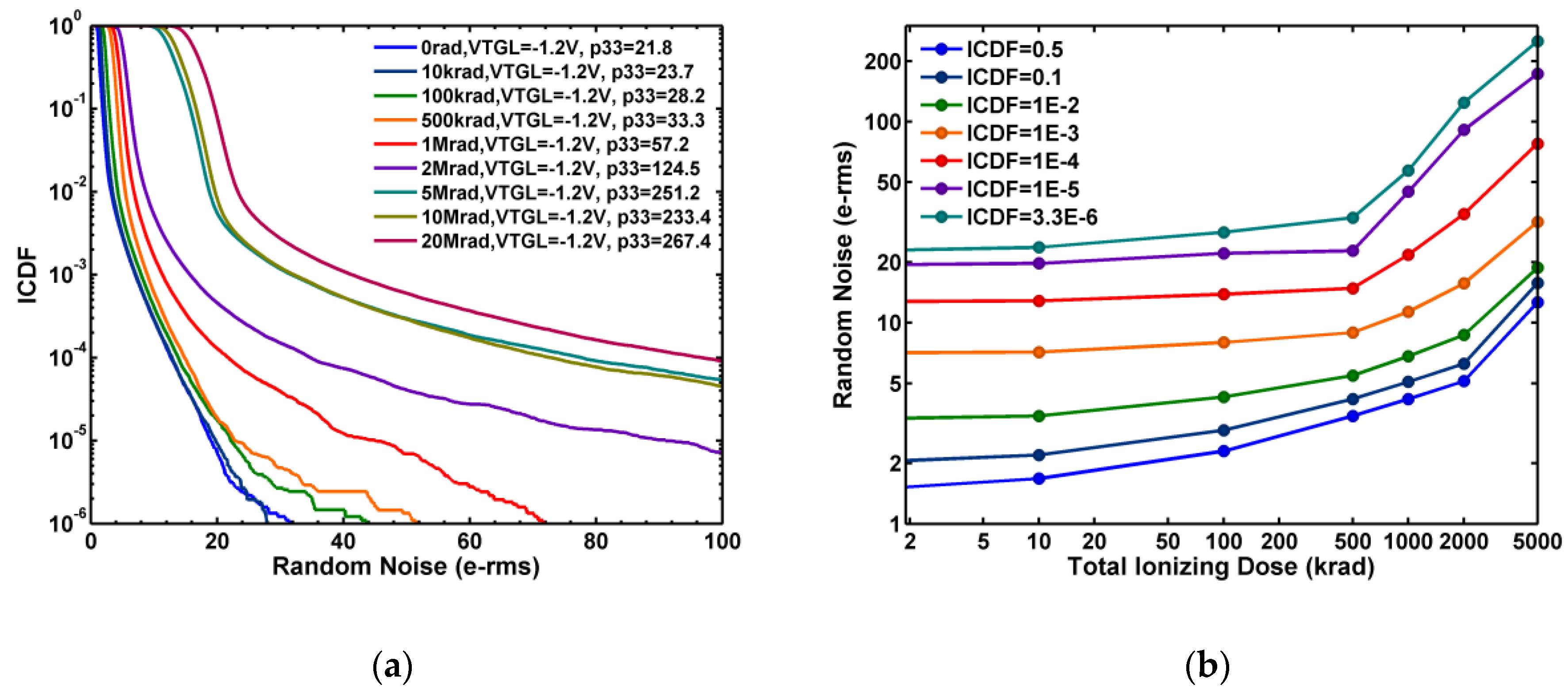
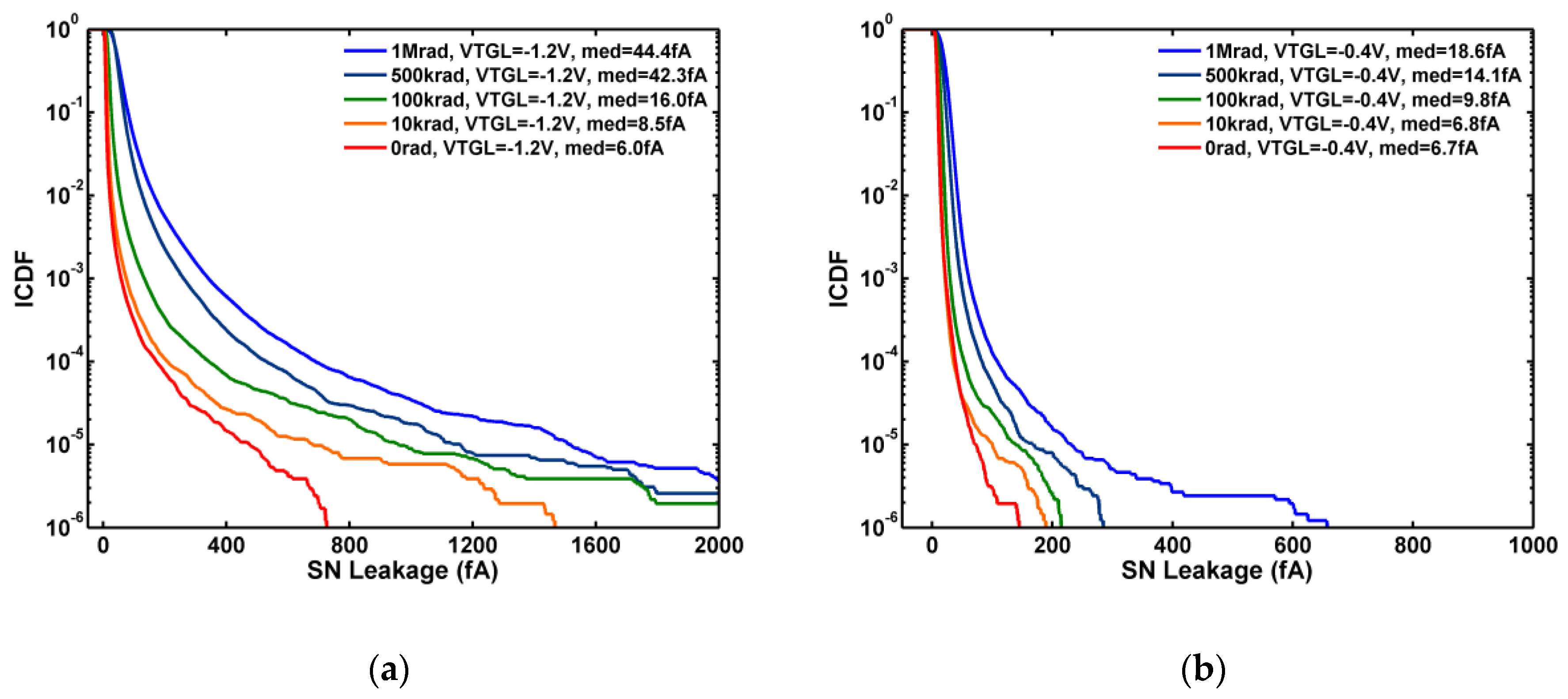

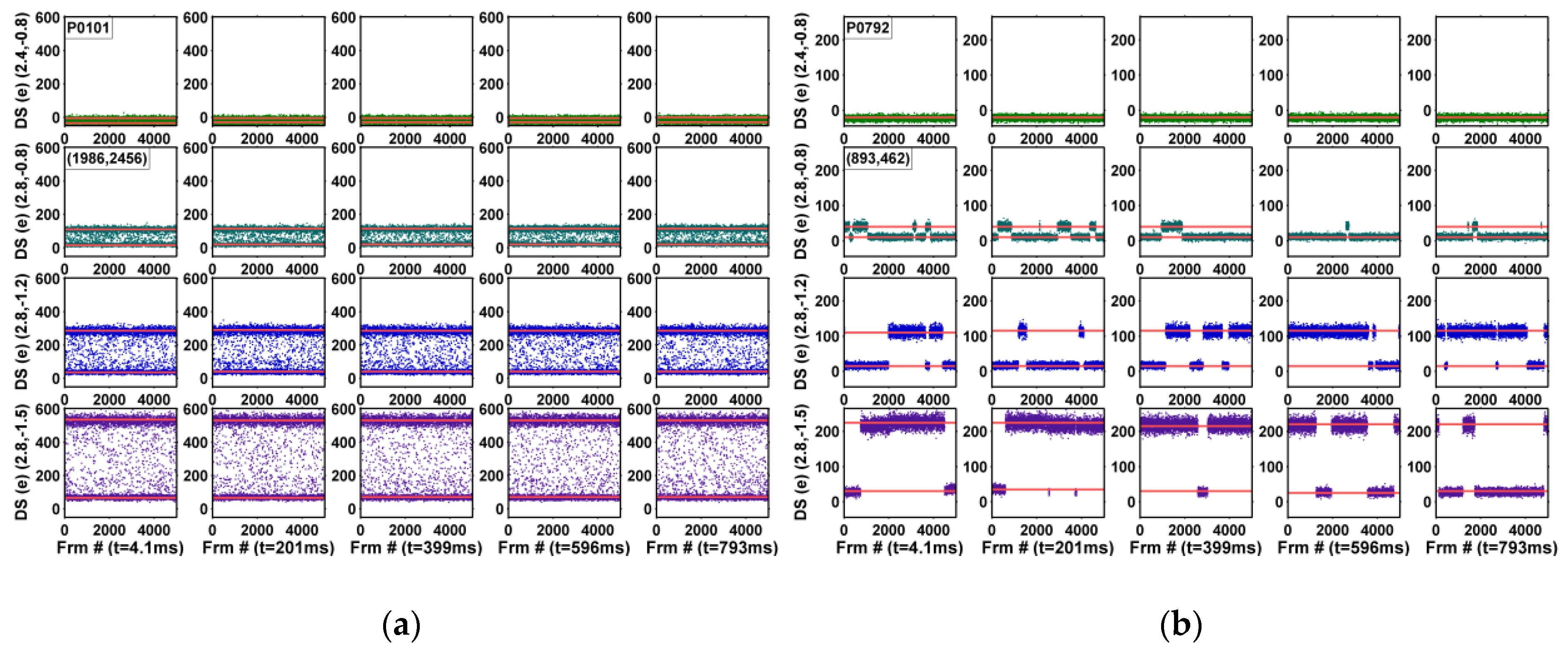






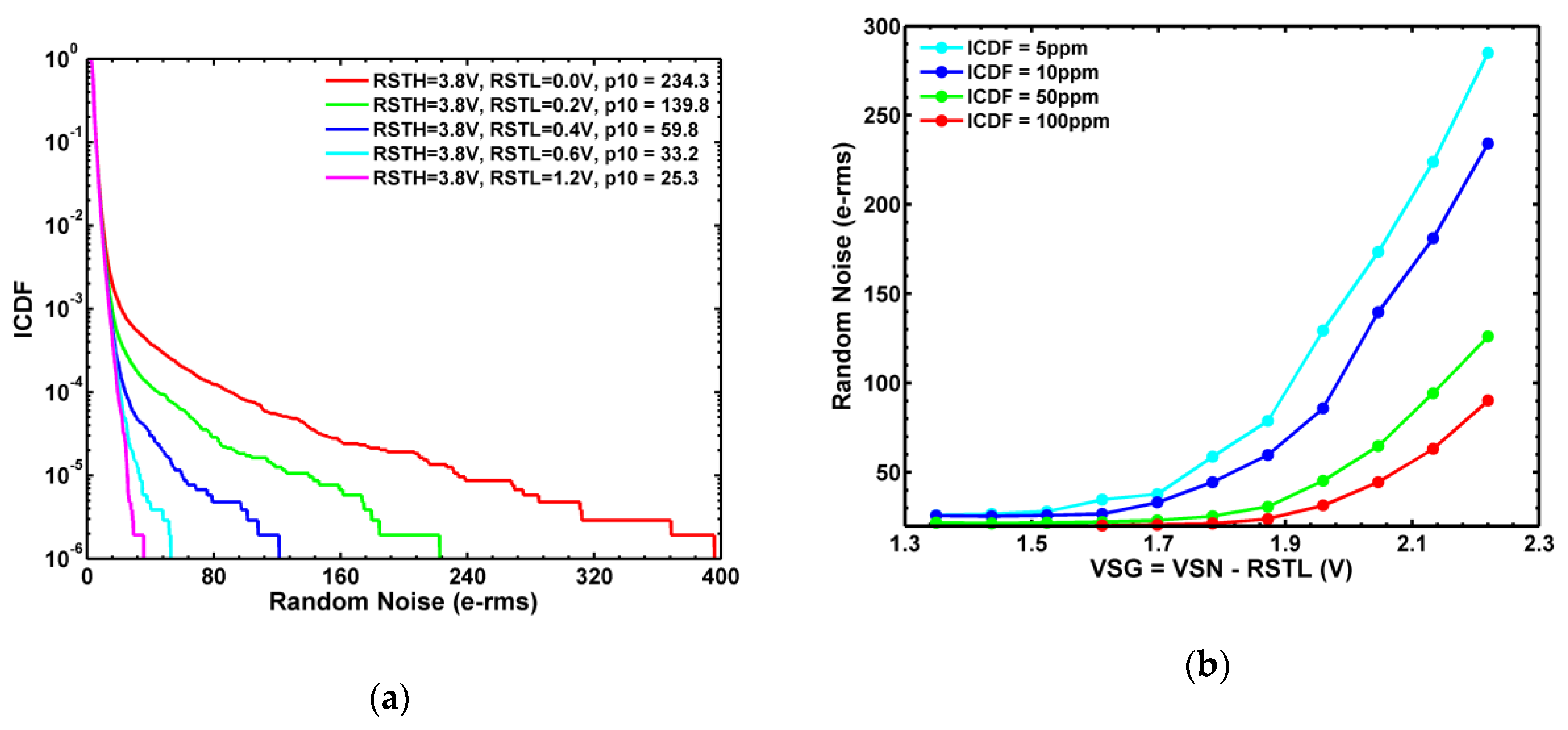
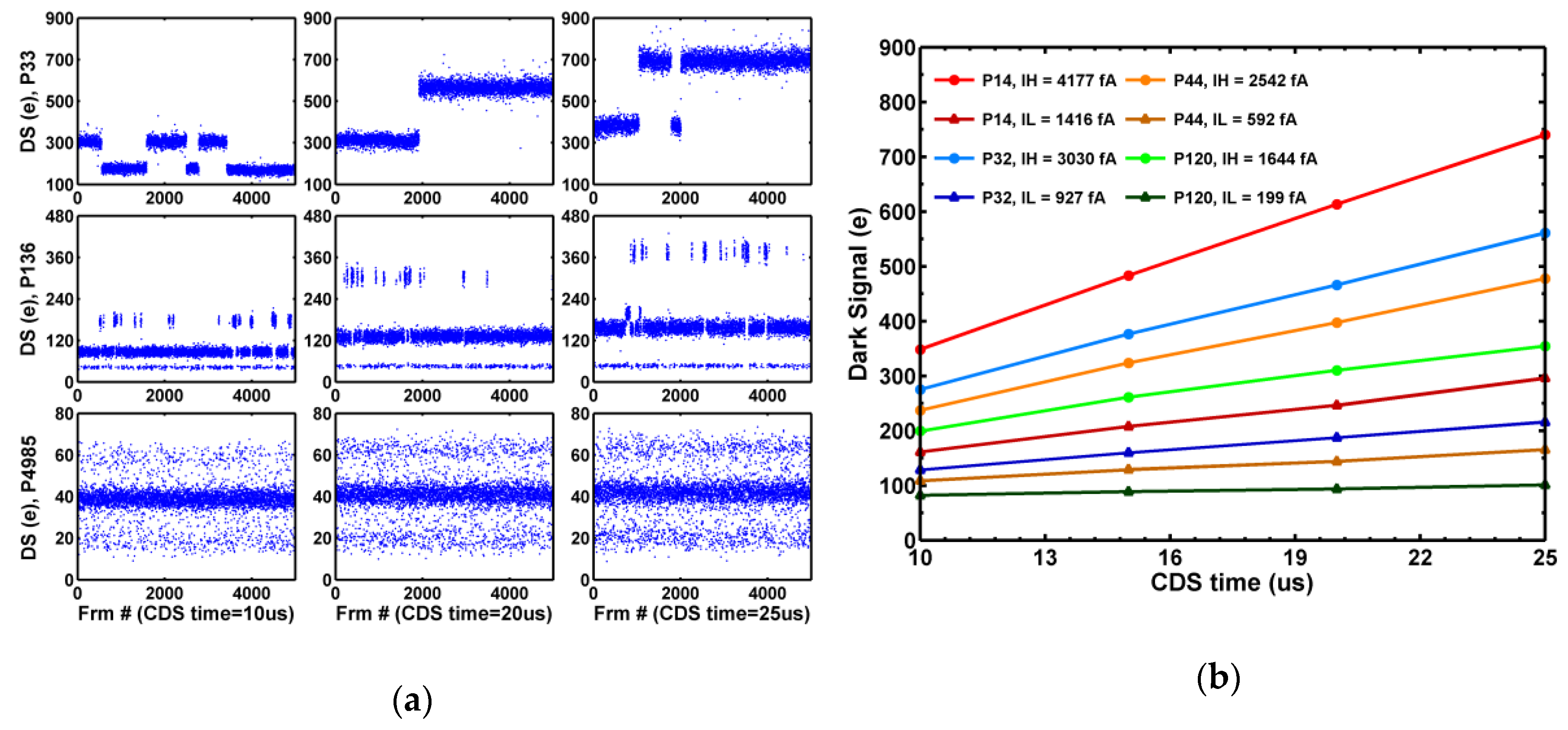
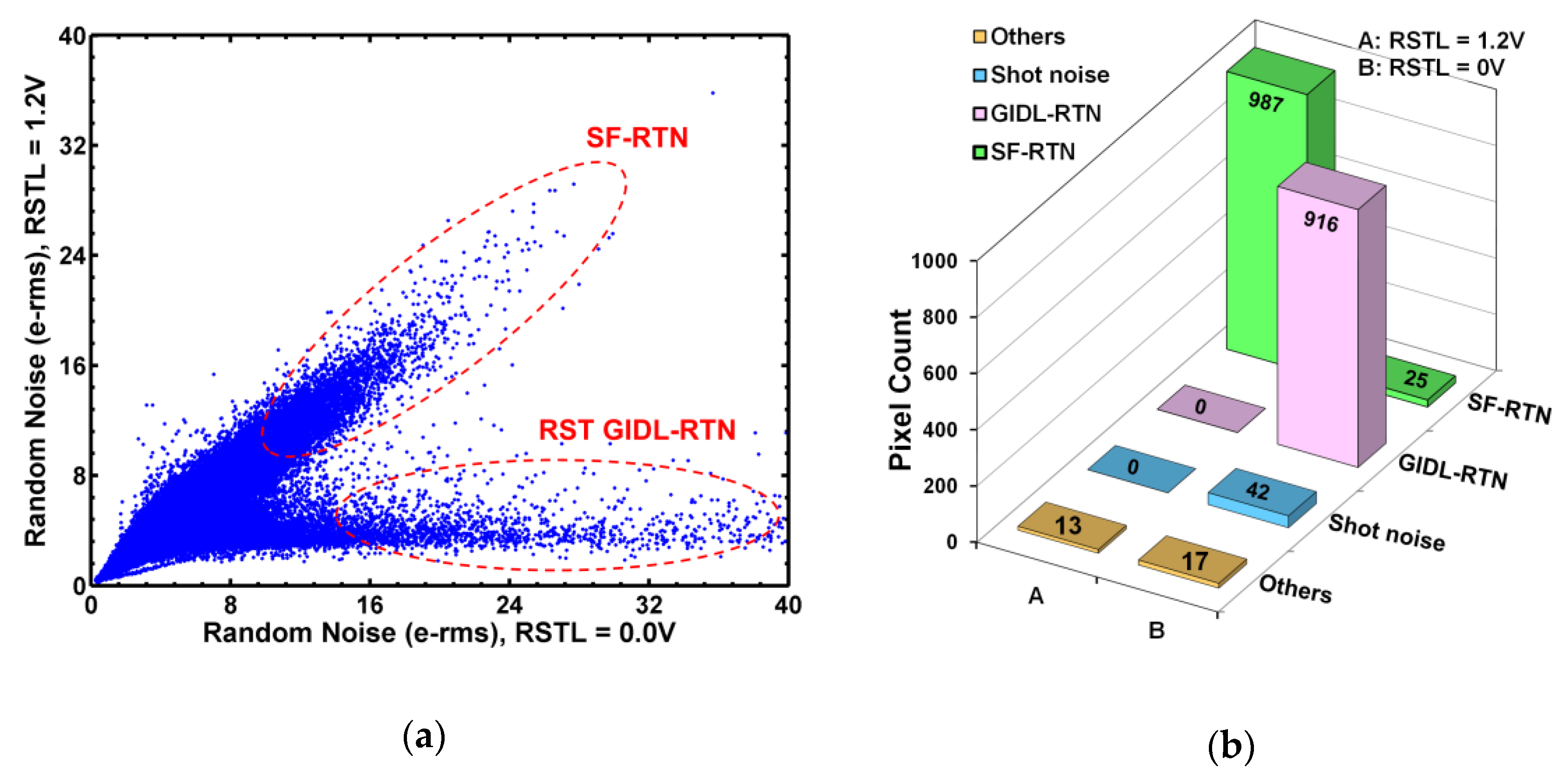



| Parameters | Chip-A | Chip-B | Operation Voltage | Chip-A | Chip-B | |
|---|---|---|---|---|---|---|
| Cell size (um2) | 1.1 × 1.1 | 3 × 2.6 | RST | RSTH | 3.1 V | 3.8 V |
| Array size | 3296 × 2512 | 1300 × 800 | RSTL | 0.0 V | 0.0 V | |
| SF W/L (um/um) | 0.2/0.8 | 0.9/1.8 | RSV | RSVH | 2.8 V | 2.8 V |
| RST W/L (um/um) | 0.2/0.4 | 0.9/0.79 | RSVL | 0.7 V | N/A | |
| SN capacitance | 1.34 fF | 3.3 fF | TG | VTGH | 2.8 V | N/A |
| SN conversion gain | 119 uV/e− | 48.5 uV/e− | VTGL | −1.2 V | N/A | |
| RN at 8X gain | 1.3 e− | 3.4 e− | VPIX | fixed | 2.7 V | 2.7 V |
| (a) | (b) | |||||
| Location | Mechanism | 4T | 3T | Nickname |
|---|---|---|---|---|
| SF | ① SF MOSFET channel RTN | Yes † | Yes ‡ | SF-RTN |
| PD | ② Transfer-gate-induced PD leakage | Yes * | N/A | N/A |
| ③ Non-gate-induced PD leakage | Yes † | Yes * | DC-RTN | |
| SN | ④ Transfer-gate induced SN leakage | Yes † | N/A | GIDL-RTN |
| ⑤ Reset-gate induced SN leakage | Yes * | Yes ‡ | GIDL-RTN | |
| ⑥ Non-gate-induced SN leakage | Yes * | Yes * | N/A |
| Random Noise Behavior | SF-RTN | TG † GIDL-RTN | RST ‡ GIDL-RTN | DC-RTN | Shot Noises |
|---|---|---|---|---|---|
| RTS behavior | Yes | Yes | Yes | Yes | No |
| PD integration time | No | No | No | Yes | Yes |
| RSVH & VTGL voltages | No * | Yes | No | No | No |
| RSVH & RSTL voltages | No * | No | Yes | No | No |
| SN charge retention time | No | Yes | Yes | No | No |
| Random Noise Behavior | SF-RTN | RST GIDL-RTN | DC-RTN | Shot Noise |
|---|---|---|---|---|
| RTS behavior | Yes | Yes | Yes | No |
| RSVH and RSTL voltages | No | Yes | No | No |
| SN charge retention time † | No | Yes | Yes | No |
© 2019 by the authors. Licensee MDPI, Basel, Switzerland. This article is an open access article distributed under the terms and conditions of the Creative Commons Attribution (CC BY) license (http://creativecommons.org/licenses/by/4.0/).
Share and Cite
Chao, C.Y.-P.; Yeh, S.-F.; Wu, M.-H.; Chou, K.-Y.; Tu, H.; Lee, C.-L.; Yin, C.; Paillet, P.; Goiffon, V. Random Telegraph Noises from the Source Follower, the Photodiode Dark Current, and the Gate-Induced Sense Node Leakage in CMOS Image Sensors. Sensors 2019, 19, 5447. https://doi.org/10.3390/s19245447
Chao CY-P, Yeh S-F, Wu M-H, Chou K-Y, Tu H, Lee C-L, Yin C, Paillet P, Goiffon V. Random Telegraph Noises from the Source Follower, the Photodiode Dark Current, and the Gate-Induced Sense Node Leakage in CMOS Image Sensors. Sensors. 2019; 19(24):5447. https://doi.org/10.3390/s19245447
Chicago/Turabian StyleChao, Calvin Yi-Ping, Shang-Fu Yeh, Meng-Hsu Wu, Kuo-Yu Chou, Honyih Tu, Chih-Lin Lee, Chin Yin, Philippe Paillet, and Vincent Goiffon. 2019. "Random Telegraph Noises from the Source Follower, the Photodiode Dark Current, and the Gate-Induced Sense Node Leakage in CMOS Image Sensors" Sensors 19, no. 24: 5447. https://doi.org/10.3390/s19245447
APA StyleChao, C. Y.-P., Yeh, S.-F., Wu, M.-H., Chou, K.-Y., Tu, H., Lee, C.-L., Yin, C., Paillet, P., & Goiffon, V. (2019). Random Telegraph Noises from the Source Follower, the Photodiode Dark Current, and the Gate-Induced Sense Node Leakage in CMOS Image Sensors. Sensors, 19(24), 5447. https://doi.org/10.3390/s19245447





